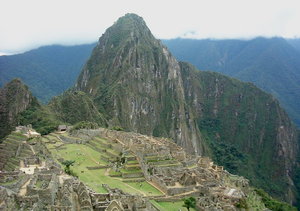Machu Picchu
|
|
Machu Picchu (literally means "old peak"; sometimes called the "Lost City of the Incas") is a well-preserved pre-Columbian town located on a high mountain ridge, at an elevation of about 6,750 feet (2,057 m) above the Urubamba Valley in modern-day Peru. The site is probably the most familiar symbol of the Inca Empire, both due to its unique location, its geological features, and its late discovery in 1911. In recent times the site has been designated as a UNESCO World Heritage Site and has been the subject of concerns about the damage of tourism.
Machu_picchu_tree.jpg
It is thought the city was built by the Sapa Inca Pachacuti starting in about 1440 and was inhabited until the Spanish conquest of Peru in 1532. Archeological evidence (together with recent work on early colonial documents) shows that Machu Picchu was not a conventional city, but a country retreat town for Incan nobility (similar to the Roman villas). The site has a large palace and temples to Incan deities around a courtyard, with other buildings for support staff. It is estimated that a maximum of only about 750 people resided in Machu Picchu at any one time, and probably only a small fraction of that number lived in the town during the rainy season and when no noblity were visiting.
It is thought that the site was chosen for its unique location and geological features. It is said that the silhouette of the mountain range behind Machu Picchu represents the face of the Inca looking upward towards the sky, with the largest peak, Waynapicchu, representing his nose. The Inca believed that the solid rock of the Earth should not be cut and so built this city from rock quarried from loose boulders found in the area. Some of the stone architecture uses no mortar, but rather relied on extremely precise cutting of blocks that results in walls with cracks between stones through which a credit card will not pass.
Intihuatana_Solar_Clock.jpg
The city was not rediscovered until July 24, 1911, when Yale University history professor Hiram Bingham III first visited it while exploring old Inca roads in the area. He was led to Machu Picchu by Quechuans who were living in Machu Picchu in the original Incan infrastructure. Bingham made several more trips and conducted excavations on the site through 1915. He wrote a number of books and articles about Machu Picchu; his popular account, Lost City of the Incas, became a bestseller.
In 1913, the site received a significant amount of publicity after the National Geographic Society devoted their entire April 1913 issue to Machu Picchu.
In 2003, some 400,000 people visited Machu Picchu, and UNESCO has expressed concern about the damage this volume of tourism is causing to the site. Peruvian authorities insist that there is no problem, and that the remoteness of the site will impose natural limits on tourism [1] (http://news.bbc.co.uk/1/hi/world/americas/3335315.stm). Periodically, proposals are made to install a cable car to the site, but such proposals have so far always been rejected. [2] (http://news.bbc.co.uk/1/hi/world/americas/428396.stm)
One of the Chilean poet Pablo Neruda's best-known works is "The Heights of Machu Picchu", inspired by the city.
External links
- QuickTime Virtual Tour of Machu Picchu and Peru from destination360.com (http://www.destination360.com/peru/machu-picchu.php)
- Machu Picchu on the Web (http://www.isidore-of-seville.com/machu/) (directory)
- "Rediscovering Machu Picchu" (http://www.yalealumnimagazine.com/issues/02_12/machupicchu.html) by Bruce Fellman, Yale Alumni Magazine (December 2002)
- Photographs of Machu Picchu (http://www.jqjacobs.net/andes/machu.html) by James Q. Jacobs
- Machu Picchu, "Lost City of the Incas" (http://agutie.homestead.com/files/MachuPicchu.htm) by Antonio Gutierrez from Geometry Step by Step from the Land of the Incas.
- Field Museum exhibit website (http://www.fieldmuseum.org/machupicchu/) Chicago. Oct. 15, 2004 - Feb 13, 2005.
- Machu Picchu on the Inca Trail (http://www.hat.net/album/south_america/peru/08_inca_trail/day_4_-_machu_picchu/index.html) Photos of Machu Picchuda:Machu Picchu
de:Machu Picchu es:Machu Picchu eo:Maĉu Piĉu fr:Machu Picchu it:Machu Picchu he:מאצ'ו פיצ'ו nl:Machu Picchu ja:マチュ・ピチュ pl:Machu Piccu pt:Machu Picchu sv:Machu Picchu zh:马丘比丘

